Andover Audio SpinSub review: Deep, vibration-free bass
Turntables, and the vinyl records we play on them, are extremely sensitive to vibration. A delicately balanced tonearm with a tiny needle glides inside a fine spiral groove precisely cut into a vinyl platter to reproduce sound that must be amplified twice: First by a phono preamp (to bring the signal to line level) and then by an amplifier or self-powered speakers. Any vibration transferred to the turntable can degrade this process or even cause the tonearm to skip.
Until Andover Audio wowed vinyl lovers with its SpinBase stereo speaker system, one would have scoffed at the notion of putting a turntable directly on top of a speaker, to say nothing of locating a subwoofer anywhere near one. Putting a subwoofer in the same stand as your turntable? That’s downright anathema.
Well, Andover Audio is poised to upend the audio world again: The all-new $299 SpinSub is a compact, vibration-free subwoofer that uses IsoGroove technology to prevent vibration from transferring to the turntable, even if the subwoofer is installed in the same piece of furniture. How did Andover Audio conjure this seemingly dark magic? Read on to find out.
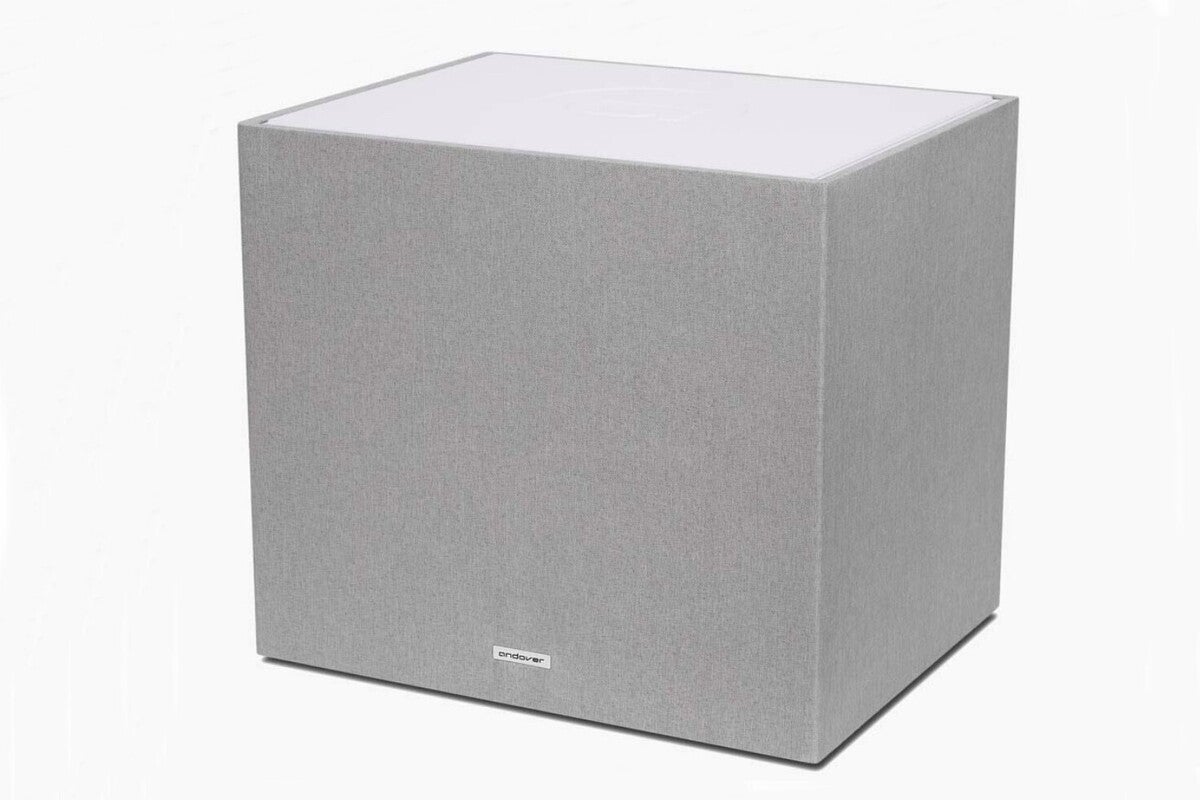 Andover Audio
Andover AudioThe Andover Audio SpinSub subwoofer is specifically designed to amplify bass response from a turntable. It uses dual force-cancelling drivers to eliminate unwanted vibration.
Specs and Design
The Andover Audio SpinSub is a compact subwoofer whose size and footprint resemble an album cover extruded into a three-dimensional cube. The SpinSub is approximately 14.25 x 12.75 x 11.25 inches (WxHxD) and should fit perfectly into many open-sided audio component racks or open-sided record album shelves. And it of course works perfectly in Andover Audio’s own SpinStand turntable stand. The SpinSub weighs in at a very respectable 21-pounds and its 19mm-thick, vented enclosure is comprised of rigid MDF (medium-density fiberboard).
The SpinSub comes in your choice of black or white fabric-covered cabinet that gives the SpinSub a decorator-friendly dressing. Andover Audio sent me the white model, whose fabric cover is a very light gray. I found the aesthetic to be a perfect complement to any white or black-colored furniture and accent pieces.
For such a small footprint (by subwoofer standards at least), the SpinSub achieves a very respectable frequency response of 32Hz to180Hz -3dB. That’s more than deep enough to reproduce a cello’s lowest notes and bass lines common to most music.
 Theo Nicolakis / IDG
Theo Nicolakis / IDGAndover Audio sent a complete Spin System setup consisting of the SpinSub, 2nd-gen SpinBase, SpinStand, and SpinDeck turntable (not pictured).
The SpinSub is powered by a Class D amplifier capable of 100W peaks. In my relatively large 24 x 34-foot listening space, the amp had no problem delivering the goods at moderate to high volume on cuts from The Eagles, Dire Straits, Peter Gabriel, and Sade; as well as soundtracks such as the Dark Knight Rises, Greatest Showman, and Star Wars: The Force Awakens.
The SpinSub sports a 3.5mm input instead of the traditional RCA input. The included 2-meter braided-nylon cable plugs directly into the sub output of any 2nd-generation Andover Audio SpinBase.
I should note that this past January, Andover Audio updated their award-winning SpinBase to include a 3.5mm subwoofer output port. Standing by early adopters, Andover Audio offers owners of the 1st-generation SpinBase—which doesn’t have such connectivity—a 50-percent-off trade-up program until September 1, 2021. You can read the details here.
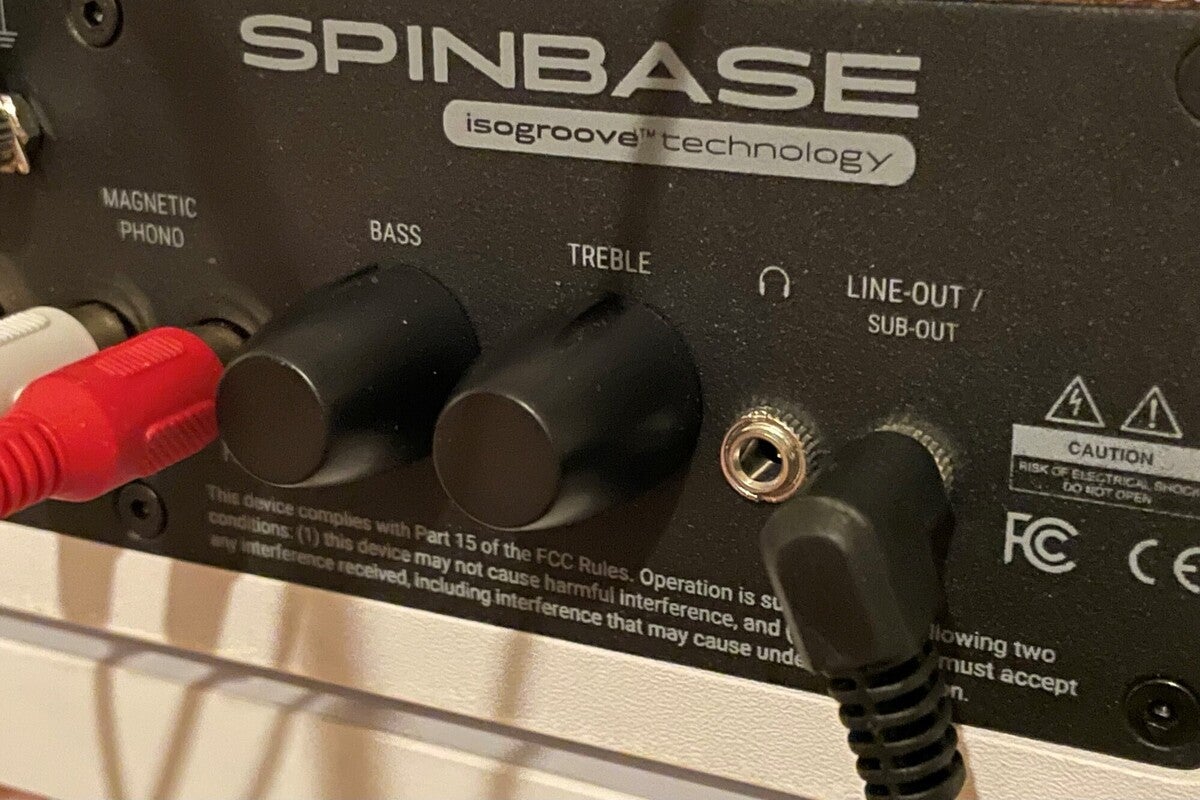 Theo Nicolakis / IDG
Theo Nicolakis / IDGThe SpinSub connects to the subwoofer output port on the Andover Audio SpinBase.
That said, the SpinSub is compatible with any speaker system, not just Andover Audio’s own SpinBase. The SpinSub includes an RCA-to-3.5mm adapter cable, so you can use it with any volume-controllable amplifier with a subwoofer output or any powered speaker with the same.
To smooth integration, the SpinSub sports an adjustable lowpass filter from 50- to 180Hz, using a 2nd-order crossover at 12dB per octave. Andover Audio tells me that when the frequency-selector knob is centered, the lowpass filter is actually at 85Hz and optimized for the SpinBase—that’s a slight deviation from the 80Hz marked on the knob’s 12-o’clock position. This lowpass filter setting should work just fine for most setups, but the optimal setting will depend on your setup and room placement. There is no phase adjustment on the SpinSub, which isn’t unusual for less-than-$500 subs such as this.
The SpinSub’s power is auto-sensing. Once you power on the unit, it will automatically go into standby mode if after a few minutes it doesn’t detect an incoming audio signal. Once the SpinSub senses an audio signal, it will wake from standby. A green LED status indicator on the back of the SpinSub lets you know when the unit is powered on.
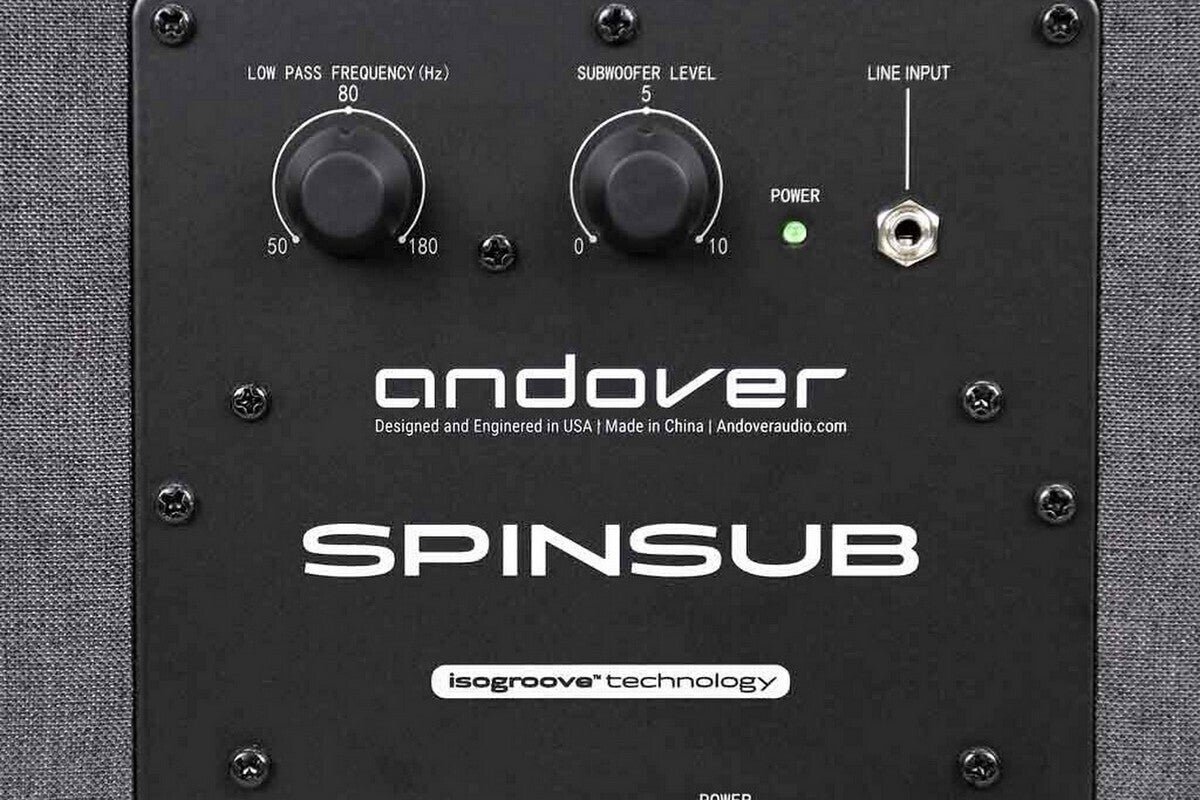 Andover Audio
Andover AudioThe Andover Audio SpinSub features volume control, variable phase, and a 3.5mm input on its rear panel.
All those specs aside, the real magic of the SpinSub’s performance lies in its dual 6.5-inch woofers situated in a vented enclosure. The woofers are pulp cones with butyl-rubber surrounds, and they feature four-layer voice coils wound on high-temperature Kapton formers (a former is the ring that a voice coil is wrapped around). Unlike the more typical subwoofer that has a single, front- or bottom-firing driver, the SpinSub sports two 6.5-inch drivers that fire from the left- and right-hand sides of the enclosure. The downside to this design choice is that you cannot place the SpinSub in a cabinet or stand that has side panels.
Using two drivers, however, gives the SpinSub several advantages. First, using two smaller drivers allowed Andover Audio to design the SpinSub with a smaller enclosure while increasing the sub’s effective output area to match a sub with a much larger, single driver.
Secondly and perhaps most importantly, using two drivers allows one driver to cancel out the vibrations of the other, rendering the SpinSub’s cabinet fundamentally inert. The approach is similar to active-noise-cancelling headphones that monitor your environment and then create an inverse soundwave to cancel the noise they detect. Indeed, I felt little to no vibration when I put my hand directly on the SpinSub’s cabinet, no matter how loud I played the music or how low the bass got. IsoGroove technology works as advertised.
In case you’re wondering, Andover Audio isn’t the first company to adopt a multi-driver, force-cancelling subwoofer design. Some of high-end audio’s most decorated brands—including Paradigm and KEF—have developed similar designs over the years. The Sonos Sub is another example.
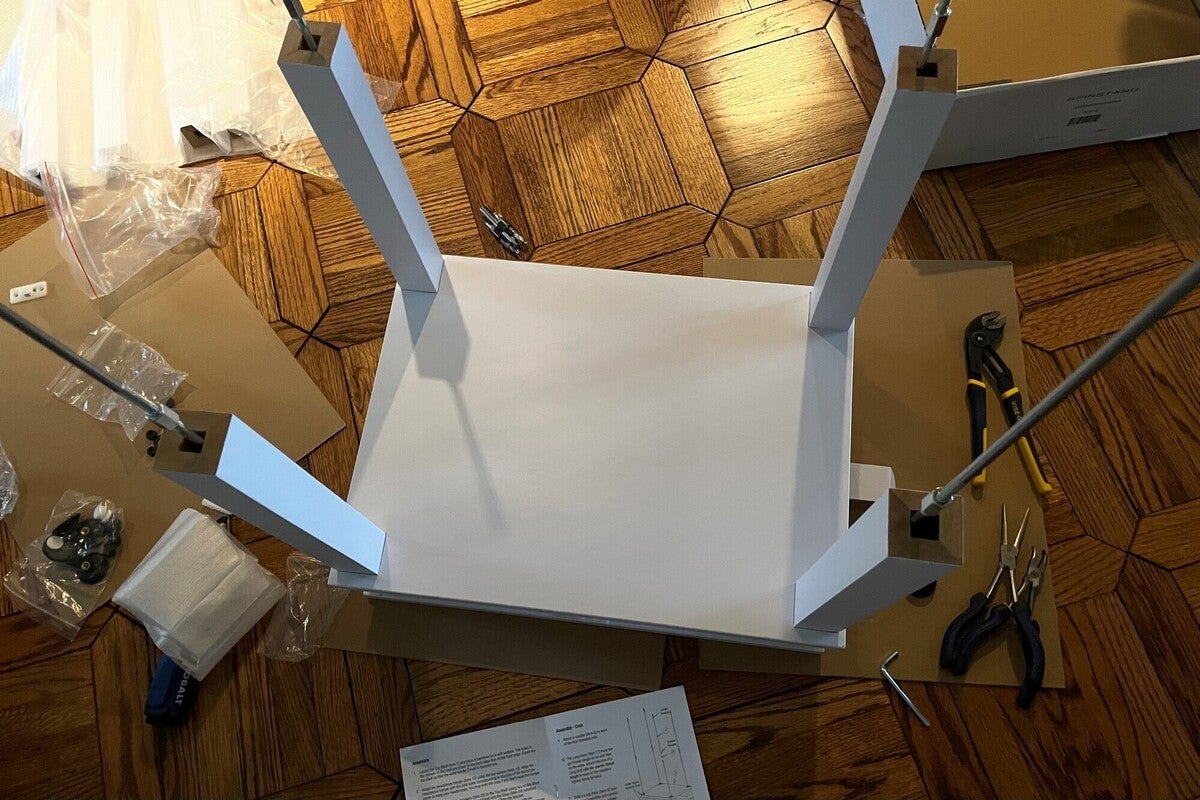 Theo Nicolakis / IDG
Theo Nicolakis / IDGSetting up the entire Spin system—including the SpinStand (pictured here with assembly in progress)—took less than an hour.
Simple to set up
Setting up the SpinSub is a piece of cake. Everything I needed was included in the box. For this review, Andover Audio sent me their complete Spin System, comprised of the $299 SpinSub, 2nd-generation SpinBase ($299), SpinDeck turntable ($349), and SpinStand record stand ($199). That’s a complete vinyl playback system with furniture for just $1,146. I also tested the SpinSub setup with a second turntable—Fluance’s $499 RT85 Reference Turntable with an Ortofon 2M Blue cartridge—during my review period:.
It took me less than an hour to assemble the SpinStand and connect the SpinBase, SpinSub, and SpinDeck—including loading the second shelf with a few dozen albums. All Spin system components complement each other aesthetically. The SpinBase fit perfectly into the SpinStand’s bottom shelf. Andover Audio does not recommend that you install the SpinBase on the middle shelf.
If you want to achieve optimal bass performance, allow me to make two observations: I cannot overemphasize that where you physically place a subwoofer—not just the SpinBase—will play the biggest role in performance. On page 9 of the user manual, Andover Audio provides insight into proper sub placement and addresses typical placement challenges. The bottom line is don’t put the SpinSub in a totally enclosed cabinet (remember its drivers fire to the sides) and if the SpinSub’s performance sounds overly boomy or bloated, try moving it around to other locations in your room. Thankfully, the SpinSub’s size and looks make it easy to fit into many different environments. You’ll simply need to provide a longer cable if needed.
Secondly, for the smoothest bass performance throughout your room, you might want to add a second SpinSub to your setup. Yes, two subs are indeed better than one. Thanks to the groundbreaking research in Sound Field Management by Harman’s Todd Welti, we know that multiple subwoofers in a room can smooth out bass response (you an geek out over the concept at this link. While Andover Audio doesn’t mention the option of a second SpinSub, all you’d need to do is purchase a 3.5mm Y adapter, connect two SpinSubs, and ideally place the Spin Subs along the 1/4 and 3/4 points of your front wall and you’d be in business just about every time.
 Andover Audio
Andover AudioThe SpinSub fits like a glove into the bottom shelf of Andover Audio’s SpinStand. The SpinSub’s heather fabric should blend perfectly with any decor.
Listening tests
I set up the SpinStand with all components towards the front of my room, where I have my reference two-channel audio system comprised of Revel Ultima2 Salon speakers and SVS SB16 and SB13-Ultra subwoofers with an Anthem AVM60 and dual Benchmark AHB2 power amps configured in dual mono. Save a slight room mode at 100Hz, my listening space doesn’t suffer from any other significant mode issues.
I’m very familiar with the SpinBase’s sound, as I’ve use the 1st-gen model frequently. Adding the SpinSub to with the 2nd-gen SpinBase delivered a completely different experience. The SpinSub filled out the bottom-end sound that, no matter how hard it tried, the SpinBase alone just couldn’t deliver.
The track “The Greatest Show,” from the Greatest Showman soundtrack, is such a superb track for an audio workout. Bass lines and dynamics were profoundly different with the SpinSub in the mix. The song starts out with a deep bass line just three seconds in, and then goes full on at the 15-second and 1:12 marks. Bass was deeper, fuller, more dynamic, and authoritative with the SpinSub in play, giving drums and bass lines far more gravitas and letting me experience the song closer to its full impact.
Turning to any of Hans Zimmer’s works will lay bare your sub’s integration. Spinning up “Terraforming” from the Man of Steel Soundtrack, unequivocally showed the sonic differences the SpinSub brought to the mix. The raw, unadulterated, mechanical grind of musical notes that paint a chaotic picture of metal, rock, and earth being pummeled came across with so much more impact. Then the hair on my arms literally stood on end when synthesizers and violins came in around the 7:50 mark, slowly triumphing, note by note.
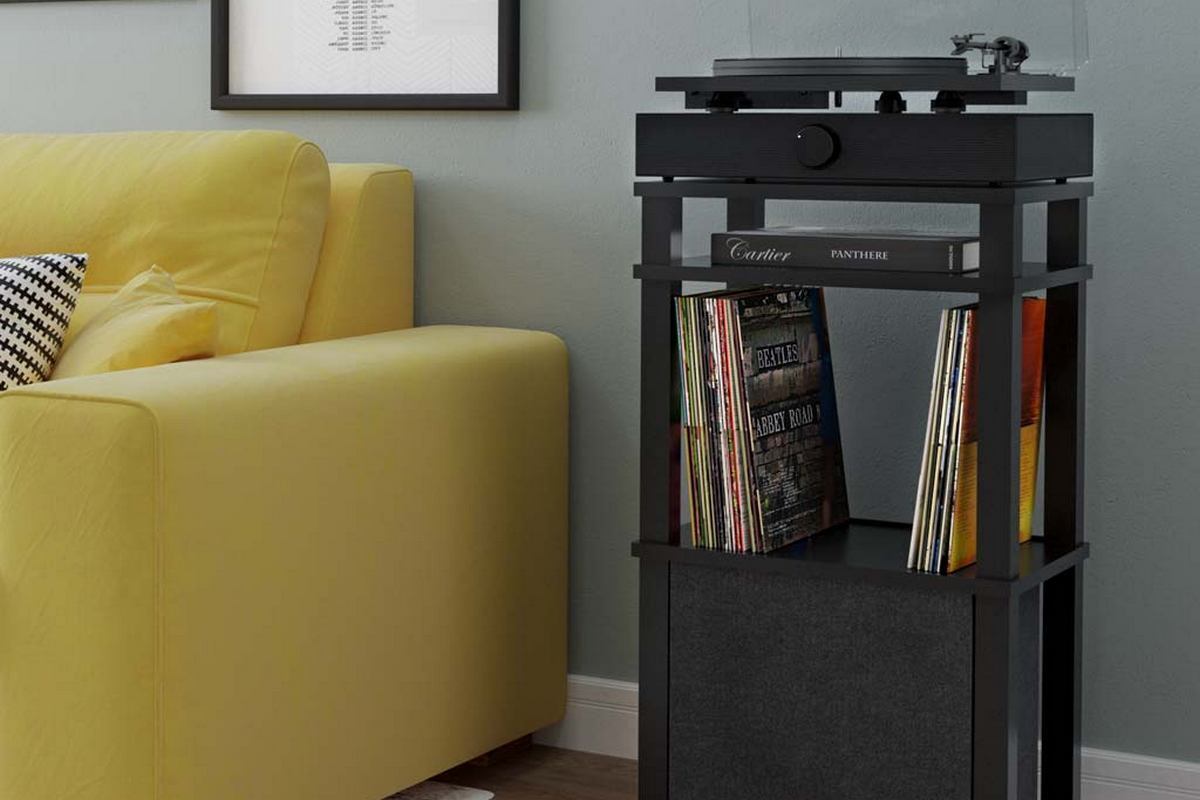 Andover Audio
Andover AudioAndover Audio’s turntable-focused audio ensemble is also available in black.
The same was true of The Dark Knight Rises soundtrack. The increased audible and physical bass sensation the SpinSub brought to “Imagine the Fire” and “Rise” raised the emotional envelopment of those songs to a level you simply cannot experience without foundational bass.
Not once did I get any sense that the SpinSub’s presence had any impact on my vinyl playback. I have to say I found it uncanny—even disorienting—to hear and feel substantive bass pressurize the room, and yet no matter how many times I put my hand on the SpinStand or the SpinBase’s cabinet, there were no resonances at all. Let me say it again: The SpinBase speaker and SpinSub were located in the same physical stand as the turntable without any adverse effect. Putting my hands to the side of the SpinSub, I felt the air move. I felt the bass. Moving my hands to the front of the cabinet? There was nothing. There we no vibrations. It was inert.
I didn’t need songs with overtly deep bass to notice the SpinSub’s contribution. Spinning up the album Eagles Live, the immortal classic “Hotel California” sounded oh-so-right with the bass the SpinSub provided for the song’s classic guitar riff.
There’s really not much to nitpick about the SpinSub at its $299 price point. Yes, the SpinSub won’t play down to 20Hz (no sub will at this price) and the SpinSub yields points on refinement, detail, and articulation (ditto). By far, however, my biggest beef with the SpinSub is that it has a tendency to render some distinct digital noise—it sounds like a muffled water faucet running in another room. I could hear the noise from even nine feet away once a record had finished playing. The sound was more pronounced if the SpinBase was on, but still reared its ugly head after the SpinBase was off.
I docked the SpinSub a half star for this anomaly. Andover Audio might want to look into see if a firmware update might fix the problem. Apart from that, did the SpinSub deliver vibration-free bass as advertised? You bet.
Conclusion
If you’re a vinyl lover who thinks Andover Audio’s SpinBase turntable speaker was a winner, you’ll dig the $299 SpinSub just as much. It’s an affordable solidly performing subwoofer designed specifically for turntables, and it delivers high value for the price tag. Add to the fact that this little guy plays bigger than its footprint; sports great aesthetic appeal; and doesn’t produce any cabinet vibrations or resonances to interfere with your vinyl playback, and you have a product that stands far above the crowd.
For all the latest Technology News Click Here
For the latest news and updates, follow us on Google News.
